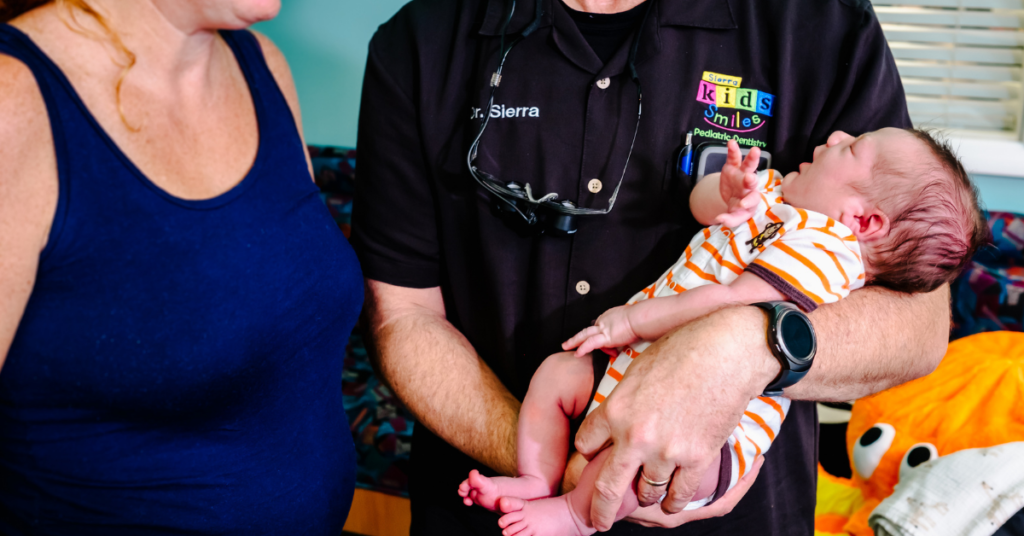Did you know that oral care should begin before your baby’s first tooth? Yes, it’s true! Your baby is born with 20 teeth nestled safely in their jaw, blanketed by their gums. When your infant begins “cutting teeth”, their teeth actually don’t cut the gums, but rather their gums move for their teeth to come through! So it’s incredibly important to keep their gums clean and healthy to set the perfect stage for their pearly whites to erupt. But how exactly do you practice newborn oral care?
Here’s a few pro tips for infant oral hygiene!
Infant Oral Care Before Teeth
Before your infant’s teeth start to come in, the CDC and the ADA recommend gently wiping their gums, tongue, and cheeks with a damp washcloth or gauze pad twice a day. This helps remove any lingering liquid or food from their gums and helps regulate their mouth bacteria.
Why is this important? Because babies produce less saliva than adults. Saliva is the body’s first defense against germs. It’s responsible for producing many important substances, such as proteins, antibacterial compounds, and minerals to help your mouth fight off infections, maintain healthy soft tissues, and even helps prevent bad breath. Establishing a strong oral care routine for your baby will help your little one become accustomed to caring for their smile and make it simple for you to adapt their oral hygiene routine as their smile grows.
If your child has started teething, keeping a handful of damp washcloths in your fridge can go a long way in alleviating their pain and fussiness. If your baby has good control over their limbs (usually around 4 to 6 months), you can offer them the washcloth and supervise while they chew their tooth pain away! Teething a damp washcloth will also help stimulate gum movement and provide relief for swollen gums.
What’s the Best Infant Oral Hygiene Routine?
Around 6 months is when your child’s teeth start to erupt! Once their tooth is through the gum line, your baby is ready to switch from a washcloth or gauze pad to a small, extra soft-bristle toothbrush.
Here’s a few of the best toothbrushes for babies (ages 0-2).
Now that you have the perfect toothbrush, it’s time to brush those new baby teeth! Before you begin, make sure you and your baby are in a comfortable position. Whether it’s with you sitting down with your infant in your lap or laying your baby on a soft surface, feet facing you. Find a position that keeps your face in your baby’s focus without straining your back or arms.
Now let’s walk through how to brush baby teeth:
- Wet toothbrush bristles with plain water
- Gently brush at a 45-degree angle for 2 minutes
- Talk or sing to your newborn while continuing to brush all surfaces of each tooth in a circular motion
- Gently brush your infant’s tongue
- When you’re finished brushing, make it a celebration! Clap your hands or praise your child accordingly.
- Be sure to brush your child’s teeth twice a day.
At baby’s first year, you can incorporate fluoride toothpaste into your child’s oral care routine. Simply apply a thin coating of toothpaste to their brush, no larger than a grain of rice.
You can help give your child a healthy smile by following these tips and scheduling regular check-ups with your pediatric dentist.
Support a Lifetime of Smiles Beginning at Birth
We’re here to answer your questions, and we want you and your child to know your options! Please don’t hesitate to reach out to us at any time.
Dr. Sierra, Dr. Kwon, Dr. Patel and our team are here to help guide you and your child. We offer kinder, gentler dentistry for kids and teens. It is our goal that your child develops and maintains a positive association with dental care and we do everything we can to create a pleasant, supportive, and fun environment for our little patients.
Ready to schedule an appointment? Let’s get started. Visit us in Town ‘n’ Country, South Tampa, North Tampa or Bradenton!

